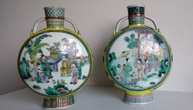
Thursday 11th October 2018 - Belle Gait

Chinese art and antiques are soaring in value, we take a look at how to spot the genuine thing.
We’ve entered into a time where we find that Chinese antiques are increasing in both their popularity and value. With China’s technological advancements, their already well-established export market and increasingly, their ability to import, China have made themselves true contenders in the foreign market.
Not only do specialist collectors around the world have an interest in Chinese antiques, but the rise in China’s economy has also meant more and more affluent Chinese citizens are now looking to return their prized historic pieces to their homeland. This means that the Chinese antique market has taken a sharp turn upwards.
Of course, we’ve all seen those famous antique vases go under the hammer for tens of thousands and even millions; perhaps, most notoriously The Meiyintang ‘Chicken Cup’ which sold for $36 million.
You may think you’ll never get your hands on an antique item of that value, but even newer pieces such as those from the Victorian Era have doubled in their worth in the last year alone. Good pieces of jade, paintings, rugs and of course ceramics can be worth hundreds of pounds.
Adding to the excitement are online bidding platforms, such as ours, which are creating a forum whereby the potential for global ‘bidding wars’ has grown exponentially. Buyers are now able to bid from and arrange shipping to almost anywhere in the world at the touch of a button.
However, the truth is Chinese porcelains and ceramics have been copied by Chinese potters and, indeed, artists around the world for hundreds of years partly out of respect for an earlier period but also to pull the wool over buyers eyes, meaning you could pay hundreds for a replica – so how do you spot the real thing?
Here at EasyLiveAuction, we have loads of auction houses who list their catalogues with us; you can easily set up auction alerts for those items you want to get notifications for, meaning you can receive email alerts regarding whenever Chinese antiques or indeed any other spectacular items you’d like to keep your eye on are listed!